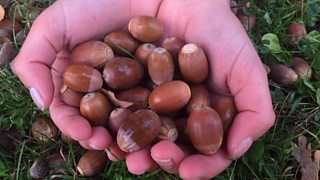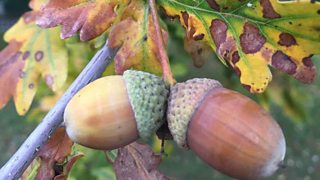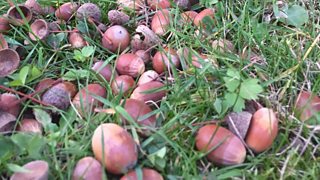By Lorienne Whittle, Nature’s Calendar Citizen Science Officer at the Woodland Trust
I just can’t help pick up a shiny conker or little capped acorn from the ground when I find them. They sometimes stay in my pocket for a while, being rubbed between my fingers on colder days. That is until I find a gap in the hedgerow or somewhere I think they can grow into mighty trees, and I plant them. It feels good to me to do these small acts which I believe help nature.
If I tried to pick up all the acorns this year however, I’d need a wheelbarrow – it seems oak trees are having a mast year and there are acorns galore as a result. But what is a ‘mast year’, why and how do trees across the UK mast simultaneously, and what are the implications for wildlife?

Have you noticed an abundance of acorns this autumn? Image by Lorienne Whittle
Is 2020 a mast year for oak?
Trees and shrubs have years where they produce a bumper crop of their fruits or nuts. This is called a mast year. The length of time between mast years varies between species.
Have you noticed the ground beneath oak trees is littered with more acorns than usual this year? The amazing thing is that it’s not just one or two oak trees that do this – somehow the vast majority of oak trees across the UK will have a mast year at the same time.
is a citizen science project run by the Woodland Trust which can help identify mast years. It gathers records on tree crop size, as well as those on the timing of various wildlife events, from eagle-eyed volunteers across the UK. From the records submitted so far this autumn, it’s looking like an exceptionally good year for acorn crops, adding to the evidence that 2020 is a mast year for oak.

Records submitted to Nature鈥檚 Calendar so far this year suggest 2020 is a mast year for oak trees. Image by Lorienne Whittle
Why produce a bumper crop?
Our native plants and animals have evolved together over thousands of years, so their lives are inextricably linked and reliant on one another. Oak trees produce acorns to ensure the next generation of trees, but in doing so provide a vital source of food for many birds and small mammals too. In turn, with their habit of storing food acorns in preparation for leaner times, animals such as jays and squirrels can also help by distributing and planting acorns away from the parent tree!
However, making acorns is costly work and in producing smaller crops for a few consecutive years, the trees are in effect keeping the populations of these animals in check. Then in a mast year there are far too many acorns for wildlife to eat, which makes sure that some acorns will survive and start to grow. This theory is called ‘predator satiation’. A mast year crop does stunt the growth of the tree slightly, but as this only occurs every five to ten years it’s a worthy pay off to ensure more saplings.

In a mast year there can be several hundred acorns in just a metre square! Image by Lorienne Whittle
What causes a mast year?
Research has shown that in a mast year the vast majority of trees in a particular species will have a fantastic crop, all across the UK. The exact way they do this is one of nature’s many mysteries. We do know that weather has a part to play though and phenology – the study of the timing of natural events in relation to the weather – can help us better understand this.
In the case of oak, the right combination of temperature and rainfall in the spring is needed to produce a healthy crop. Acorns develop from the female flower on an oak tree, and every year the trees produce a similar amount of flowers, but they result in a varying number of acorns. It is the fertilisation of the oak flowers that is important to produce acorns and for that, pollination is needed. Oak trees are wind pollinated, so a dry and warm spring creates good conditions for an abundance of acorns in the autumn.
How you can help
Recording with Nature’s Calendar, citizen scientists rate the crop size of their local oak trees on a scale of 1-5. Their results show that the largest average crop for oak in the last 20 years of recordings was 2013, but we’ll have to wait until the end of the season to see how 2020 matches up.
Have you seen an exceptional amount of fruit or nuts on a tree or shrub near you this year? Get recording and help us to determine whether or not we are in a mast year!
There are nearly 150 events you can record throughout the year involving trees, flowers, insects, birds and amphibians too. Put together, these records are used to study the effects of weather and climate change on our wildlife. By taking a few minutes to share what you see, you'll be adding to hundreds of years' worth of important data. We need to know what is going on with wildlife near you, and we couldn't do this work without you! Find out more at:
